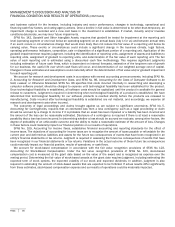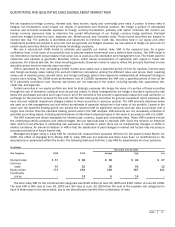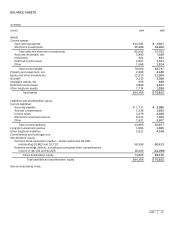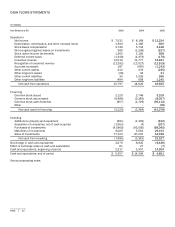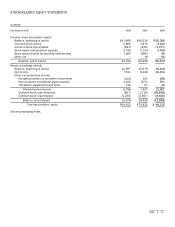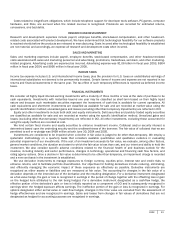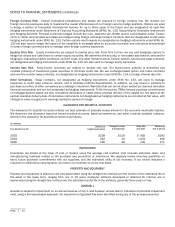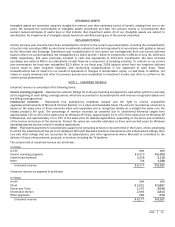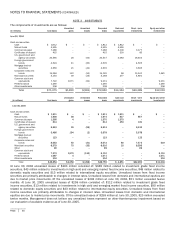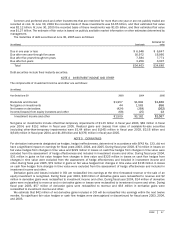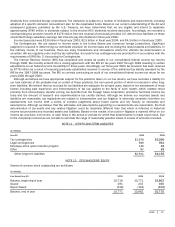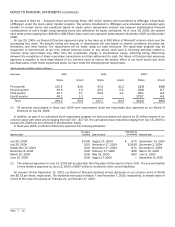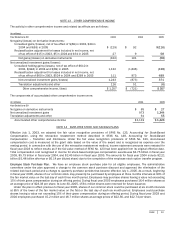Microsoft 2005 Annual Report Download - page 44
Download and view the complete annual report
Please find page 44 of the 2005 Microsoft annual report below. You can navigate through the pages in the report by either clicking on the pages listed below, or by using the keyword search tool below to find specific information within the annual report.
PAGE 43
Costs related to insignificant obligations, which include telephone support for developer tools software, PC games, computer
hardware, and Xbox, are accrued when the related revenue is recognized. Provisions are recorded for estimated returns,
concessions, and bad debts.
RESEARCH AND DEVELOPMENT
Research and development expenses include payroll, employee benefits, stock-based compensation, and other headcount-
related costs associated with product development. We have determined that technological feasibility for our software products
is reached shortly before the products are released to manufacturing. Costs incurred after technological feasibility is established
are not material, and accordingly, we expense all research and development costs when incurred.
SALES AND MARKETING
Sales and marketing expenses include payroll, employee benefits, stock-based compensation, and other headcount-related
costs associated with sales and marketing personnel and advertising, promotions, tradeshows, seminars, and other marketing-
related programs. Advertising costs are expensed as incurred. Advertising expense was $1.06 billion in fiscal year 2003, $904
million in fiscal year 2004, and $995 million in fiscal year 2005.
INCOME TAXES
Income tax expense includes U.S. and international income taxes, plus the provision for U.S. taxes on undistributed earnings of
international subsidiaries not deemed to be permanently invested. Certain items of income and expense are not reported in tax
returns and financial statements in the same year. The tax effect of such temporary differences is reported as deferred income
taxes.
FINANCIAL INSTRUMENTS
We consider all highly liquid interest-earning investments with a maturity of three months or less at the date of purchase to be
cash equivalents. Investments with maturities beyond one year may be classified as short-term based on their highly liquid
nature and because such marketable securities represent the investment of cash that is available for current operations. All
cash equivalents and short-term investments are classified as available for sale and are recorded at market value using the
specific identification method; unrealized gains and losses (excluding other-than-temporary impairments) are reflected in OCI.
Equity and other investments include both debt and equity instruments. Debt securities and publicly traded equity securities
are classified as available for sale and are recorded at market using the specific identification method. Unrealized gains and
losses (excluding other-than-temporary impairments) are reflected in OCI. All other investments, excluding those accounted for
using the equity method, are recorded at cost.
We lend certain fixed income and equity securities to enhance investment income. Collateral and/or security interest is
determined based upon the underlying security and the creditworthiness of the borrower. The fair value of collateral that we are
permitted to sell or re-pledge was $499 million at both June 30, 2004 and 2005.
Investments are considered to be impaired when a decline in fair value is judged to be other-than-temporary. We employ a
systematic methodology on a quarterly basis that considers available quantitative and qualitative evidence in evaluating
potential impairment of our investments. If the cost of an investment exceeds its fair value, we evaluate, among other factors,
general market conditions, the duration and extent to which the fair value is less than cost, and our intent and ability to hold the
investment. We also consider specific adverse conditions related to the financial health of and business outlook for the
investee, including industry and sector performance, changes in technology, operational and financing cash flow factors, and
rating agency actions. Once a decline in fair value is determined to be other-than-temporary, an impairment charge is recorded
and a new cost basis in the investment is established.
We use derivative instruments to manage exposures to foreign currency, equities price, interest rate and credit risks, to
enhance returns, and to facilitate portfolio diversification. Our objectives for holding derivatives include reducing, eliminating,
and efficiently managing the economic impact of these exposures as effectively as possible. Derivative instruments are
recognized as either assets or liabilities and are measured at fair value. The accounting for changes in the fair value of a
derivative depends on the intended use of the derivative and the resulting designation. For a derivative instrument designated
as a fair-value hedge, the gain or loss is recognized in earnings in the period of change together with the offsetting loss or gain
on the hedged item attributed to the risk being hedged. For a derivative instrument designated as a cash-flow hedge, the
effective portion of the derivative’s gain or loss is initially reported as a component of OCI and is subsequently recognized in
earnings when the hedged exposure affects earnings. The ineffective portion of the gain or loss is recognized in earnings. For
options designated either as fair-value or cash-flow hedges, changes in the time value are excluded from the assessment of
hedge effectiveness and are recognized in earnings. Gains and losses from changes in fair values of derivatives that are not
designated as hedges for accounting purposes are recognized in earnings.





